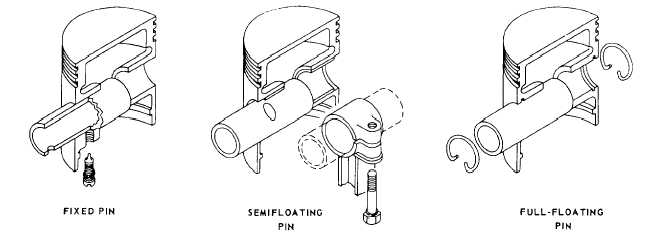Figure 12-17.-Piston pin types.
expanded by the heat generated during operation, it
becomes round because the expansion is proportional to
the temperature of the metal. The walls of the skirt are
cut away as much as possible to reduce weight and to
prevent excessive expansion during engine operation.
Many aluminum pistons are made with split skirts so
that when the pistons expand, the skirt diameter will not
increase.
The two types of piston skirts found in most engines
are the full trunk and the slipper. The full-trunk-type
skirt, more widely used, has a full cylindrical shape with
bearing surfaces parallel to those of the cylinder, giving
more strength and better control of the oil film. The
slipper-type (cutaway) skirt has considerable relief on
the sides of the skirt, leaving less area for possible
contact with the cylinder walls and thereby reducing
friction.
PISTON PINS.— The piston is attached to the
connecting rod by the piston pin (wrist pin). The pin
passes through the piston pin bosses and through the
upper end of the connecting rod, which rides within the
piston on the middle of the pin. Piston pins are made of
alloy steel with a precision finish and are case hardened
and sometimes chromium plated to increase their
wearing qualities. Their tubular construction gives them
maximum strength with minimum weight. They are
lubricated by splash from the crankcase or by pressure
through passages bored in the connecting rods.
Three methods are commonly used for fastening a
piston pin to the piston and the connecting rod: fixed
pin, semifloating pin, and full-floating pin (fig. 12-17).
The anchored, or fixed, pin attaches to the piston by a
screw running through one of the bosses; the connecting
rod oscillates on the pin. The semifloating pin is
anchored to the connecting rod and turns in the piston
pin bosses. The full-floating pin is free to rotate in the
connecting rod and in the bosses, while plugs or
snap-ring locks prevent it from working out against the
sides of the cylinder.
PISTON RINGS.— Piston rings are used on
pistons to maintain gastight seals between the pistons
and cylinders, to aid in cooling the piston, and to control
cylinder-wall lubrication. About one-third of the heat
absorbed by the piston passes through the rings to the
cylinder wall. Piston rings are often complicated in
design, are heat treated in various ways, and are plated
with other metals. Piston rings are of two distinct
classifications: compression rings and oil control rings.
(See fig. 12-18.)
The principal function of a compression ring is to
prevent gases from leaking by the piston during the
compression and power strokes. All piston rings are split
to permit assembly to the piston and to allow for
expansion. When the ring is in place, the ends of the split
joint do not form a perfect seal; therefore, more than one
ring must be used, and the joints must be staggered
around the piston. If cylinders are worn, expanders (figs.
12-15 and 12-18) are sometimes used to ensure a perfect
seal.
The bottom ring, usually located just above the
piston pin, is an oil-regulating ring. This ring scrapes the
excess oil from the cylinder walls and returns some of
it, through slots, to the piston ring grooves. The ring
groove under an oil ring has openings through which the
oil flows back into the crankcase. In some engines,
additional oil rings are used in the piston skirt below the
piston pin.
12-16


